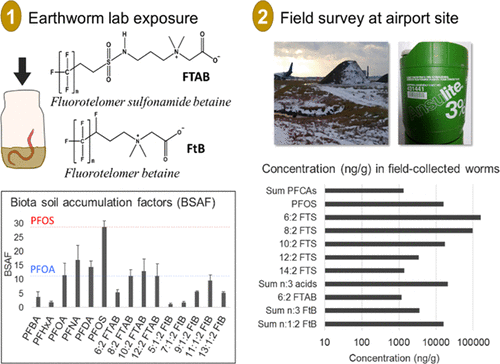当前位置:
X-MOL 学术
›
Environ. Sci. Technol.
›
论文详情
Our official English website, www.x-mol.net, welcomes your
feedback! (Note: you will need to create a separate account there.)
Bioaccumulation of Zwitterionic Polyfluoroalkyl Substances in Earthworms Exposed to Aqueous Film-Forming Foam Impacted Soils.
Environmental Science & Technology ( IF 10.8 ) Pub Date : 2020-01-22 , DOI: 10.1021/acs.est.9b05102 Gabriel Munoz 1 , Mélanie Desrosiers 2 , Laura Vetter 1, 3 , Sung Vo Duy 1 , Julie Jarjour 4 , Jinxia Liu 4 , Sébastien Sauvé 1
Environmental Science & Technology ( IF 10.8 ) Pub Date : 2020-01-22 , DOI: 10.1021/acs.est.9b05102 Gabriel Munoz 1 , Mélanie Desrosiers 2 , Laura Vetter 1, 3 , Sung Vo Duy 1 , Julie Jarjour 4 , Jinxia Liu 4 , Sébastien Sauvé 1
Affiliation

|
Critical knowledge gaps remain regarding the fate and effects of zwitterionic, cationic, and anionic perfluoroalkyl and polyfluoroalkyl substances (PFASs), including assessment of their bioaccumulation potential. Here, biota soil accumulation factors (BSAFs) were assessed in earthworms (Eisenia fetida) exposed to soil microcosms amended with zwitterionic fluorotelomers and anionic perfluoroalkyl acids. The 6:2 fluorotelomer sulfonamidoalkyl betaine (6:2 FTAB) bioaccumulated in earthworms [BSAF ∼ 2.5-5.4 (gdw,worm/gdw,soil)-1] but to a lesser extent than perfluorooctane sulfonate (PFOS: BSAF ∼ 21-29). The BSAF of perfluorocarboxylates increased from ∼2.0 for C4-C6 analogues to ∼92 for perfluorotridecanoate (C13). In earthworms exposed to Ansulite and Arctic Foam aqueous film-forming foams (AFFFs), the BSAF was related to perfluorinated chain length for n:3 fluorotelomer betaines (FtBs), n:1:2 FtB, and n:2 FTAB. Earthworms were also collected in situ from a fire-equipment testing site at a major Canadian airport. Summed PFAS concentrations were between 65 000 and 830 000 ng g-1 wet weight, possibly the highest burden recorded in terrestrial biota. Fluorotelomer sulfonates (6:2 FTS, 8:2 FTS, and 10:2 FTS) and FtB were particularly prevalent. Field worms also displayed elevated concentrations of n:3 acids (n = 3-11), but not those from laboratory microcosms exposed to fluorotelomer-based AFFFs. The findings provide an important confirmation to recent data suggesting that fluorotelomer compounds may accumulate in invertebrate species with limited metabolization.
中文翻译:

暴露于水成膜泡沫的Earth中两性离子多氟烷基物质的生物蓄积性。
关于两性离子,阳离子和阴离子全氟烷基和多氟烷基物质(PFAS)的命运和影响,仍然存在关键的知识空白,包括对其生物蓄积潜力的评估。在这里,评估了to(Eisenia fetida)暴露于土壤两栖动物的micro中的生物群落土壤蓄积因子(BSAFs),其中两性离子含氟调聚物和阴离子全氟烷基酸被修饰。bio中生物积累的6:2氟调聚物磺酰胺基烷基甜菜碱(6:2 FTAB)[BSAF约为2.5-5.4(gdw,蠕虫/ gdw,土壤)-1],但程度要小于全氟辛烷磺酸盐(PFOS:BSAF约为21-29) )。全氟羧酸的BSAF从C4-C6类似物的〜2.0增加到全氟十三烷酸酯(C13)的〜92。在暴露于Ansulite和Arctic Foam水性成膜泡沫(AFFF)中的earth中,BSAF与n:3氟调聚物甜菜碱(FtBs),n:1:2 FtB和n:2 FTAB的全氟化链长有关。还从加拿大主要机场的消防设备测试现场就地收集了collected。PFAS总浓度在65,000至830 000 ng g-1湿重之间,可能是陆地生物区系中记录的最高负担。含氟调聚物的磺酸盐(6:2 FTS,8:2 FTS和10:2 FTS)和FtB特别流行。田间蠕虫还显示出高浓度的n:3酸(n = 3-11),但未暴露于暴露于基于氟调聚物的AFFF的实验室微观环境中。这些发现为最近的数据提供了重要的证实,表明含氟调聚物化合物可能在代谢受限的无脊椎动物中蓄积。还从加拿大主要机场的消防设备测试现场就地收集了collected。PFAS总浓度在65,000至830 000 ng g-1湿重之间,可能是陆地生物区系中记录的最高负担。含氟调聚物的磺酸盐(6:2 FTS,8:2 FTS和10:2 FTS)和FtB特别流行。田间蠕虫还显示出高浓度的n:3酸(n = 3-11),但未暴露于暴露于基于氟调聚物的AFFF的实验室微观环境中。这些发现为最近的数据提供了重要的证实,表明含氟调聚物化合物可能在代谢受限的无脊椎动物中蓄积。还从加拿大主要机场的消防设备测试现场就地收集了collected。PFAS总浓度在65,000至830 000 ng g-1湿重之间,可能是陆地生物区系中记录的最高负担。含氟调聚物的磺酸盐(6:2 FTS,8:2 FTS和10:2 FTS)和FtB特别流行。田间蠕虫还显示出高浓度的n:3酸(n = 3-11),但未暴露于暴露于基于氟调聚物的AFFF的实验室微观环境中。这些发现为最近的数据提供了重要的证实,表明含氟调聚物化合物可能在代谢受限的无脊椎动物中蓄积。可能是陆地生物区系中记录的最高负担。含氟调聚物的磺酸盐(6:2 FTS,8:2 FTS和10:2 FTS)和FtB特别流行。田间蠕虫还显示出高浓度的n:3酸(n = 3-11),但未暴露于暴露于基于氟调聚物的AFFF的实验室微观环境中。这些发现为最近的数据提供了重要的证实,表明含氟调聚物化合物可能在代谢受限的无脊椎动物中蓄积。可能是陆地生物区系中记录的最高负担。含氟调聚物的磺酸盐(6:2 FTS,8:2 FTS和10:2 FTS)和FtB特别流行。田间蠕虫还显示出高浓度的n:3酸(n = 3-11),但未暴露于暴露于基于氟调聚物的AFFF的实验室微观环境中。这些发现为最近的数据提供了重要的证实,表明含氟调聚物化合物可能在代谢受限的无脊椎动物中蓄积。
更新日期:2020-01-23
中文翻译:

暴露于水成膜泡沫的Earth中两性离子多氟烷基物质的生物蓄积性。
关于两性离子,阳离子和阴离子全氟烷基和多氟烷基物质(PFAS)的命运和影响,仍然存在关键的知识空白,包括对其生物蓄积潜力的评估。在这里,评估了to(Eisenia fetida)暴露于土壤两栖动物的micro中的生物群落土壤蓄积因子(BSAFs),其中两性离子含氟调聚物和阴离子全氟烷基酸被修饰。bio中生物积累的6:2氟调聚物磺酰胺基烷基甜菜碱(6:2 FTAB)[BSAF约为2.5-5.4(gdw,蠕虫/ gdw,土壤)-1],但程度要小于全氟辛烷磺酸盐(PFOS:BSAF约为21-29) )。全氟羧酸的BSAF从C4-C6类似物的〜2.0增加到全氟十三烷酸酯(C13)的〜92。在暴露于Ansulite和Arctic Foam水性成膜泡沫(AFFF)中的earth中,BSAF与n:3氟调聚物甜菜碱(FtBs),n:1:2 FtB和n:2 FTAB的全氟化链长有关。还从加拿大主要机场的消防设备测试现场就地收集了collected。PFAS总浓度在65,000至830 000 ng g-1湿重之间,可能是陆地生物区系中记录的最高负担。含氟调聚物的磺酸盐(6:2 FTS,8:2 FTS和10:2 FTS)和FtB特别流行。田间蠕虫还显示出高浓度的n:3酸(n = 3-11),但未暴露于暴露于基于氟调聚物的AFFF的实验室微观环境中。这些发现为最近的数据提供了重要的证实,表明含氟调聚物化合物可能在代谢受限的无脊椎动物中蓄积。还从加拿大主要机场的消防设备测试现场就地收集了collected。PFAS总浓度在65,000至830 000 ng g-1湿重之间,可能是陆地生物区系中记录的最高负担。含氟调聚物的磺酸盐(6:2 FTS,8:2 FTS和10:2 FTS)和FtB特别流行。田间蠕虫还显示出高浓度的n:3酸(n = 3-11),但未暴露于暴露于基于氟调聚物的AFFF的实验室微观环境中。这些发现为最近的数据提供了重要的证实,表明含氟调聚物化合物可能在代谢受限的无脊椎动物中蓄积。还从加拿大主要机场的消防设备测试现场就地收集了collected。PFAS总浓度在65,000至830 000 ng g-1湿重之间,可能是陆地生物区系中记录的最高负担。含氟调聚物的磺酸盐(6:2 FTS,8:2 FTS和10:2 FTS)和FtB特别流行。田间蠕虫还显示出高浓度的n:3酸(n = 3-11),但未暴露于暴露于基于氟调聚物的AFFF的实验室微观环境中。这些发现为最近的数据提供了重要的证实,表明含氟调聚物化合物可能在代谢受限的无脊椎动物中蓄积。可能是陆地生物区系中记录的最高负担。含氟调聚物的磺酸盐(6:2 FTS,8:2 FTS和10:2 FTS)和FtB特别流行。田间蠕虫还显示出高浓度的n:3酸(n = 3-11),但未暴露于暴露于基于氟调聚物的AFFF的实验室微观环境中。这些发现为最近的数据提供了重要的证实,表明含氟调聚物化合物可能在代谢受限的无脊椎动物中蓄积。可能是陆地生物区系中记录的最高负担。含氟调聚物的磺酸盐(6:2 FTS,8:2 FTS和10:2 FTS)和FtB特别流行。田间蠕虫还显示出高浓度的n:3酸(n = 3-11),但未暴露于暴露于基于氟调聚物的AFFF的实验室微观环境中。这些发现为最近的数据提供了重要的证实,表明含氟调聚物化合物可能在代谢受限的无脊椎动物中蓄积。











































 京公网安备 11010802027423号
京公网安备 11010802027423号